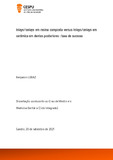| dc.contributor.advisor | ANDRADE, MARIA CATARINA COSTA CALAMOTE | |
| dc.contributor.author | Lebaz, Benjamin | |
| dc.date.accessioned | 2022-03-08T12:04:58Z | |
| dc.date.available | 2022-03-08T12:04:58Z | |
| dc.date.issued | 2022 | |
| dc.identifier.uri | http://hdl.handle.net/20.500.11816/3896 | |
| dc.description.abstract | Introdução: Na evolução das técnicas de restauração dentaria, os métodos indiretos encontraram seu lugar entre as restaurações diretas e as próteses convencionais, na grande preocupação da integridade do tecido dentário. Atualmente dois grupos de materiais são os mais utilizados: as cerâmicas e as resinas compostas.
Objetivos: O objetivo deste estudo consiste em realizar uma revisão sistemática da literatura que visa comparar a taxa de sucesso de inlays/onlays em resina composta com as cerâmicas, em dentes posteriores.
Metodologia: A pesquisa bibliográfica foi realizada na base de dados PubMed, assim como no Google scholar usando as palavras-chave e as suas combinações. Foram reunidos um total de 74 artigos, dos quais 13 foram considerados relevantes.
Resultados/Discussão: Vários estudos mostram a importância dos fatores que podem influenciar essa taxa de sucesso. Entre esses fatores temos os fatores relacionados ao próprio material e os fatores específicos das condições técnicas de realização dessas restaurações indiretas. No geral, as taxas de sucesso das restaurações indiretas em cerâmica e em resina composta excedem 90% e essas restaurações mostram alta fiabilidade.
Conclusão: As evidencias são muito limitadas para afirmar que a cerâmica tem um desempenho melhor que a resina composta para a confeção dos inlays/onlays a curto prazo. No entanto este resultado pode não ser valido a longo prazo, sendo necessários mais estudos. | pt_PT |
| dc.description.abstract | Introduction : In the evolution of dental restoration techniques, indirect methods have found their place between direct restorations and conventional prostheses, with great concern for the integrity of dental tissue. Currently, two groups of materials are the most used: ceramics and composite resins.
Objectives : The main objective of this study is to carry out a systematic review of the literature which aims to compare the success rate of composite resin inlays/onlays compared to ceramic in posterior teeth.
Methodology : The bibliographic search was carried out in the PubMed database, as well as in Google Scholar using the keywords and their combinations. A total of 74 articles were collected, of which 13 were deemed relevant.
Results/Discussion : Several studies show the importance of the factors that can influence this success rate. Among these factors: factors related to the material itself and factors specific to the technical conditions of making these indirect restorations. Overall, success rates of ceramic and composite resin indirect restorations exceed 90% and these restorations exhibit high reliability.
Conclusion : The evidence is very limited to state that ceramic performs better than composite resin for making short-term inlays/onlays. However, this result may not be valid in the long term, so further studies are needed. | pt_PT |
| dc.language.iso | por | pt_PT |
| dc.rights | info:eu-repo/semantics/openAccess | pt_PT |
| dc.subject | Inlay | pt_PT |
| dc.subject | Onlay | pt_PT |
| dc.subject | Ceramic | pt_PT |
| dc.subject | Composite | pt_PT |
| dc.subject | Evaluation | pt_PT |
| dc.subject | Survival | pt_PT |
| dc.title | Inlays/onlays em resina composta versus Inlays/onlays em cerâmica em dentes posteriores : taxa de sucesso | pt_PT |
| dc.type | info:eu-repo/semantics/masterThesis | pt_PT |
| dc.identifier.tid | 202948382 | pt_PT |
| thesis.degree.name | Mestrado em Medicina Dentária | pt_PT |

